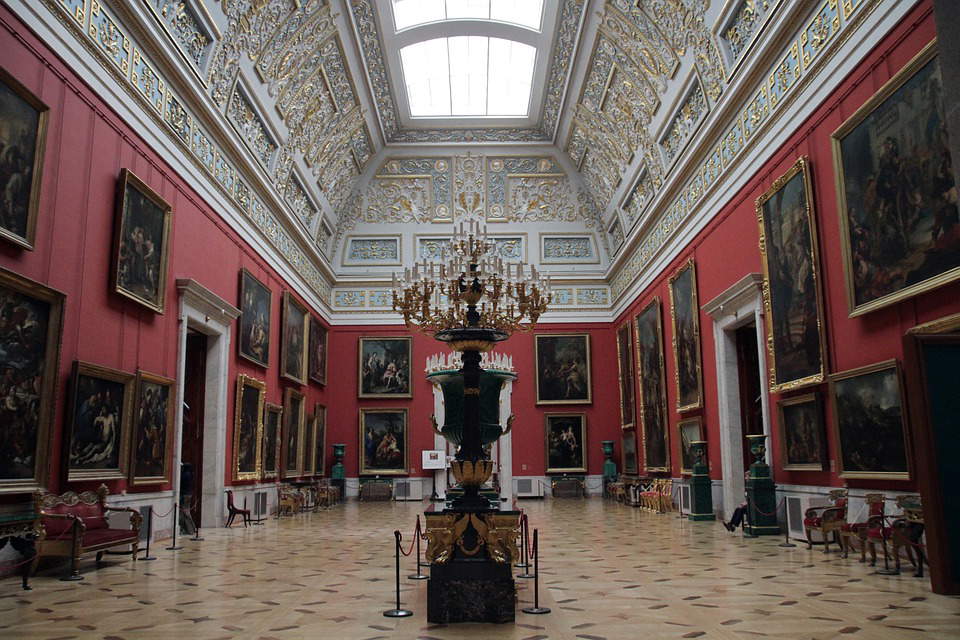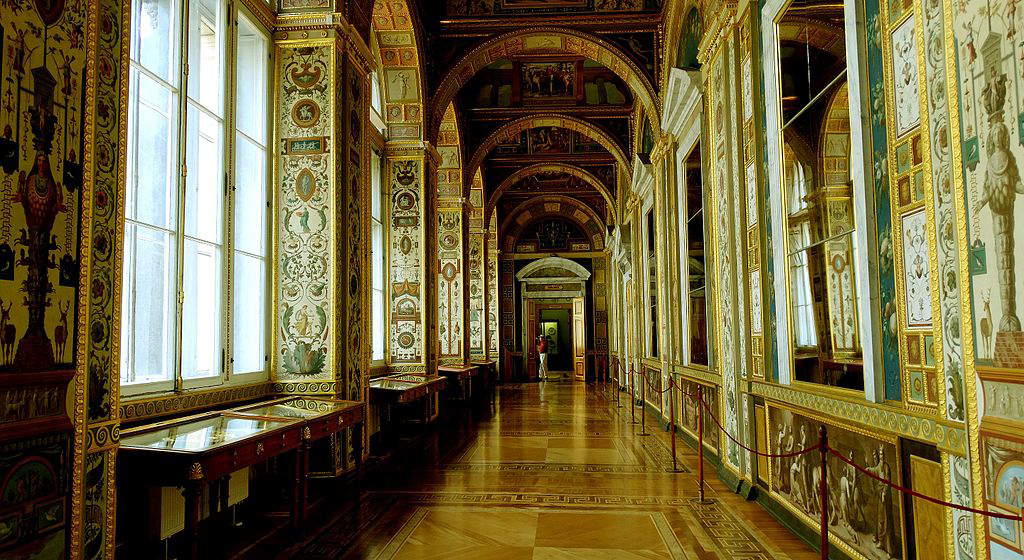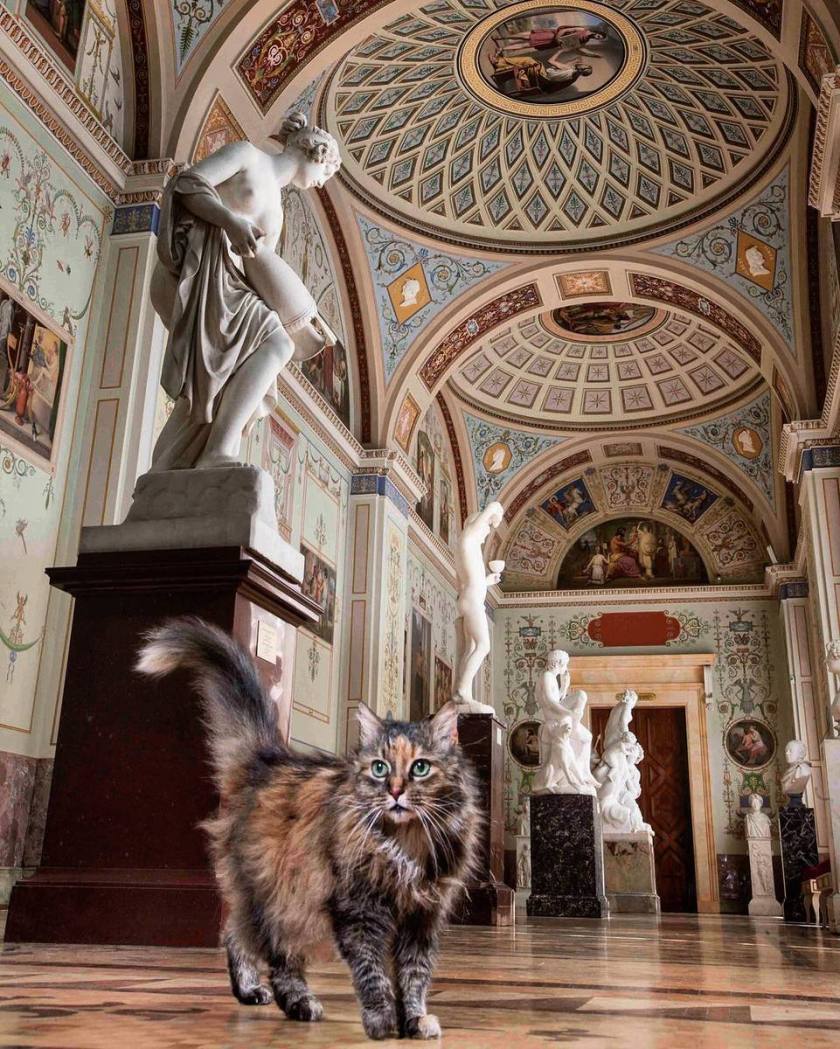TheHermitage (or Hermitage) in St. Petersburg is much more than a museum: it is a complex of buildings devoted entirely to art, housing one of the world’s most extensive collections. Five buildings comprise it: the Winter Palace, the oldest, designed between 1754 and 1762 by the Italian Francesco Bartolomeo Rastrelli (Paris, 1700 - St. Petersburg, 1771); the Small Hermitage, which gives its name to the whole complex, designed between 1764 and 1775 by Jan-Baptiste Vallin de la Mothe and Jurij Veldten, and then again the Great Hermitage (1771-1787) by Jurij Veldten, the Hermitage Theater also designed between 1783 and 1789 by an Italian, namely Giacomo Quarenghi (Rota d’Imagna, 1744 - St. Petersburg, 1817), and finally the most recent, the New Hermitage, the work of Leo von Klenze from 1839-1851. However, the history of the complex began in 1754, when Empress Elisabeth Petrovna approved the project for a new winter residence in the Baroque style, assigned precisely to Rastrelli: the goal was to have a palace built whose beauty would overshadow that of all the other sumptuous European palaces. It was a huge construction site, requiring the work of four thousand people (who finished the work in nine years: few, considering the size of the structure), and as soon as it opened the palace immediately attracted the attention and praise of many who were able to see it.
Elizabeth passed away in 1762, and she was succeeded by Tsarina Catherine the Great, who wanted a smaller, more dim building in which she could get away from the court and daily duties to spend a few secluded moments. Thus the Petit Hermitage was born: it was the empress herself who wanted to use French (in wide use at the Russian court) to christen the new pavilion, with a name that would make clear its function, namely that of retreat, a kind of “hermitage” under the banner of art. Vallin de la Mothe designed a neoclassical building that would provide all the appropriate comforts for the tsarina: not only private apartments, but also drawing rooms for receptions, an audience room (in case she had to hold official engagements in this private residence as well), and even a greenhouse. In the meantime, the tsarina’s opulent collection (consisting of works of art as well as a great many books) had grown to the point that a new building was needed, which in 1771 Catherine commissioned from Jurij Veldten. This was then joined in 1792 by an extension by Giacomo Quarenghi (the same architect who, as anticipated, designed the Theater), which would be distinguished by a bizarre feature: the Raphael Loggias, rooms that faithfully reproduced Raphael’s frescoes from the Vatican Palace in Rome. (To make sure they were as close as possible to the originals, the tsarina in 1778 sent a team of artists to Rome to copy them onto large canvases that were then shipped to St. Petersburg.
 |
| The Winter Palace |
 |
| Leonardo da Vinci’s Madonna Benois |
 |
| The monumental staircase of the Winter Palace |
 |
| Room 238, dedicated to Italian painting |
 |
| The Loggias of Raphael |
 |
| One of the Hermitage’s cats |
In the meantime, the Hermitage collection had been enriched with important nuclei: the collections of Count Bruhl, Baron Pierre Crozat, Sir Robert Walpole, Count Baudouin, John Lyde Browne, Josephine Bonaparte and other great collectors of the time whose works went to swell the palaces’ collections were acquired. On December 17, 1837, a major fire, which lasted three days, devastated part of the Winter Palace’s interior decorations.The damage was contained only to the oldest palace because, to prevent the flames from spreading, all the passages connecting the Winter Palace to the Little Hermitage were dismantled. The palace was then restored under Nicholas I, who saw to it that the rooms at the front of the palace and those facing Nevsky Prospect were rebuilt exactly as they were. 1914 was another important year in the history of the Hermitage: it was the year of the acquisition of Leonardo da Vinci’s Benois Madonna, which came to the museum along with other works of the Benois family. The Russian Revolution led, in 1917, to the transformation of the Hermitage and the Winter Palace into a state museum, following an official announcement by the People’s Commissar for Education, Anatolij Lunacharskij: it took four years to prepare and finally, in 1921, the first rooms opened to the public. Not only that: the Winter Palace became a place where the public could attend films, concerts and lectures in the state rooms. A Museum of the October Revolution had also been set up in the Winter Palace, moreover. In 1941, during World War II, a massive evacuation of the Hermitage’s works began, and they were brought to safety in storage facilities located in the Ural Mountains: they would return when the conflict was over. After the war, the museum continued to grow and open exhibitions, both during the Soviet era and after Perestroika, and today it is one of the most visited and active museums in the world, with several collaborations with other institutions around the globe.
It is, of course, reductive to provide a description of the Hermitage’s vast collections, which number thousands of works: a visit necessarily requires one to choose one’s favorite themes in order to focus one’s attention, which would otherwise be inexorably sucked in by the breadth of the collection. Italian art is well represented, with a collection of works from the 13th to the 17th century (highlights include Raphael’s Madonna Connestabile, Correggio’s Dame, Giorgione’s Madonna and Child and Judith, Leonardo da Vinci’s aforementioned Madonna Benois, Caravaggio’s Lute Player, and then works by Beato Angelico, Filippo Lippi, Giulio Romano, Lorenzo Lotto, Titian, Perugino, Guido Reni, Carlo Dolci, and many other great Italian artists) and with neoclassical sculptures by artists such as Antonio Canova and Carlo Finelli, and great space is also given to Holland with two distinct nuclei, one generally devoted to Dutch art (there are also paintings by Vincent van Gogh) and one on Golden Age painting. Again, present is a collection of French art from the 15th to 18th centuries and a nucleus of modern French painting, the latter with an important selection of Impressionist art (several works by Claude Monet and Pierre-Auguste Renoir) and works by Paul Cézanne. Flemish painting from all periods and German art from the 15th to the 18th century are also well represented, as, of course, are the very rich Russian collections, particularly of 18th-century art (to which two different sections of the collection are devoted). Then again there is the Spanish painting section and the English art section, while for lovers of archaeology a visit to the section devoted to the ancient cultures of Eurasia is recommended. There is also a rich armory with pieces ranging from the 15th to the 19th century.
The Hermitage is also a cultural center of considerable importance, with research activities throughout Russia under its belt. The first research center to have been opened by the institute is the one in Kazan’ (opened in 2005): exhibitions and educational projects intended for the region are developed there. Particularly important was the opening of the Exhibition Center in Vyborg, a Russian city on the border with Finland, as well as a popular tourist destination, in 2010: it has become one of the main poles of cultural expansion in Russia for the St. Petersburg museum, which also has plans to expand into Europe (indeed, it is already doing so: in 2009 it opened an additional center in Amsterdam). There are many projects that the museum is pursuing: restorations, exhibitions, studies and research, international collaborations activated with important institutes beyond the Russian borders (including in Italy, with the Hermitage Italy center, founded in Ferrara and then moved to Venice, through which various exhibitions have been organized).
Finally, a curiosity: the Hermitage in St. Petersburg is also famous for its ... guard cats. Apparently, the introduction of the felines (with the purpose of chasing mice out of the Winter Palace) was due to Elizabeth Petrovna herself, who hosted a colony of cats specially flown in from Kazan’. The idea was successful, and even her successors decided to keep them (even, Catherine the Great introduced the distinction between house and court cats, with the latter having the privilege of being able to roam the most beautiful rooms of the architectural complex). On these pages you will also find an in-depth look at the history of the Hermitage’s cats, who to this day continue to accompany tourists entering the museum with their sly and somewhat shy presence.
 |
| The Hermitage in St. Petersburg: five buildings, one of the world's largest art collections |
Warning: the translation into English of the original Italian article was created using automatic tools. We undertake to review all articles, but we do not guarantee the total absence of inaccuracies in the translation due to the program. You can find the original by clicking on the ITA button. If you find any mistake,please contact us.